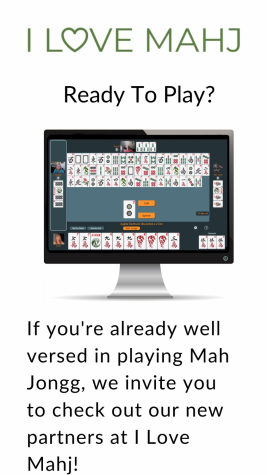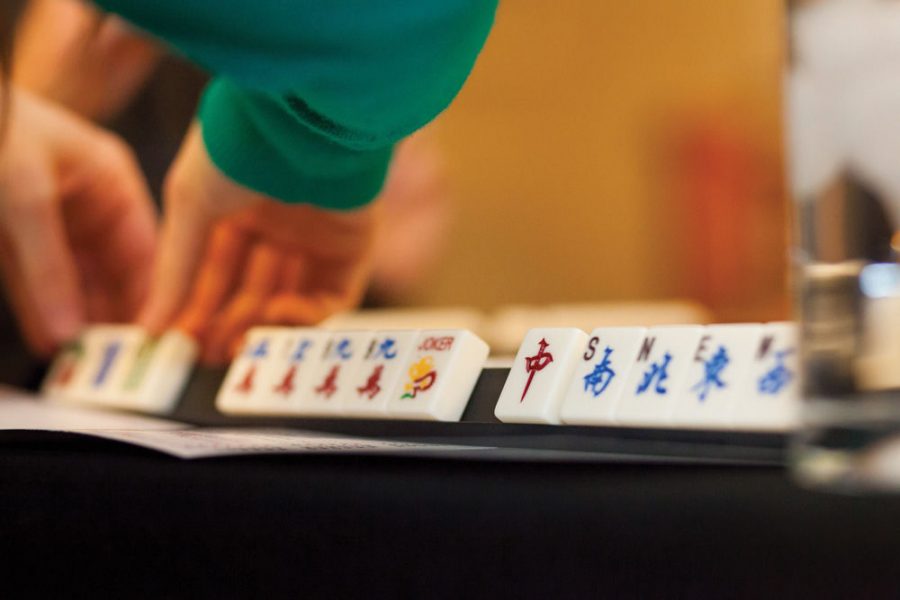This Week in Mah Jongg: Playing the Game (Part 2)
Published August 10, 2021
Hello again and welcome to this week’s Mah Jongg tutorial from the team at I Love Mahj! Last time we discussed the early part of the game, including setting up and the various parts of the Charleston. This time, we’ll be moving into the main segment of the game. Hold on tight as we navigate our way through the numerous rules and nuances of this fascinating game!

Order of Play
In this section, we’ll cover the general order of play, and in subsequent sections we’ll explain each in more detail, along with the associated rules.
So, let’s continue from where we left off last time, at the end of the Charleston. East has 14 tiles (everyone else has 13 tiles) and starts the game by discarding an unwanted tile. At this point, all players have 13 tiles in their hand (remember, 14 tiles are required for Mah Jongg). The turn then moves in a counterclockwise manner to the player on East’s right, who picks a tile from the wall (their 14th tile), placing it on the sloped part of their rack, and then discards a tile.
When a tile is discarded, another player can decide to call the tile to make an exposure (see Calling a Tile section below). The caller would place this tile, along with others from their hand, on the top part of their rack, visible to all, and then discard a tile to complete their turn. Play would then continue in a counterclockwise direction from the caller's position (note that when someone calls a discarded tile, players sitting between the discarder and the caller will miss their turn, as play now continues from this point). Each player takes it in turn to pick a tile from the wall and discard an unwanted tile from their hand, until someone calls “Mah Jongg” or there are no more tiles to pick (this is called a “wall game” and will be discussed in our next article). We’ll cover the various aspects of play in a little more detail below.
Walls
You’ll recall that we previously described how each player builds a wall in front of their rack, 19 tiles wide by 2 tiles high (38 tiles in total). Walls are pushed out in turn once all tiles from the previous wall have been used in the game.
East’s wall is the first to be pushed out, and this process moves in a clockwise direction, so the player on East’s left will push out their wall next and so on. Walls are pushed out with the right-most end of the wall being pushed towards the center of the table, leaving the left-most end closest to the player pushing out. Modern Mah Jongg racks include a pusher to enable this to be easily accomplished. If no pusher is included with your racks, then a long ruler or similar shaped object can be used to complete this action.
Drawing & Racking
A player starts their turn by drawing a tile from the active wall. This tile is selected from the end of the wall closest to the center of the table and the tile is then placed on the tilted side of the player’s rack (visible only to them). The racking of a tile is the signal that the previously discarded tile can no longer be called by another player at the table.
Once all tiles have been picked from the active wall, the next wall (in clockwise order) is pushed out. Tiles are then picked in turn from this wall. In some online games, the tile is automatically drawn and given to you; in others, you need to click a button to expressly request it.
Discarding
After drawing a tile from the wall (or calling a discarded tile), players will re-examine their hand and decide which tile they wish to discard next. In an in-person game, the player would place their discarded tile in the center of the table, face up, and verbally announce it (eg, "one bam" or "north").
In online games, a tile is generally discarded by either double-clicking on the unwanted tile or dragging it to the center of the screen. The tile is announced by the computer.
Once a tile is named or discarded by a player it cannot be taken back. Discarding a tile signals the end of that player’s turn.
Calling a Tile
Once a tile has been discarded, players have the option to call that particular tile in order to complete a grouping (pung, kong, etc) for an exposure. However, there is a limited window of opportunity in which to call a discarded tile: the time between a player discarding a tile and the next player picking and racking their tile from the wall. Once the next player has racked their tile the window of opportunity has closed.
So, just to clarify, you would call a discarded tile if you required it to complete a combination for the hand you are aiming for on the card (ie, a grouping of 3, 4, or 5 of the same tile).
To call a discarded tile:
- Announce the call verbally (saying "call" is sufficient or “I need that tile”, etc)
- Pick up the tile and place it face-up on top of your rack for all to see. Add matching tiles (which can include jokers) from your rack to complete the combination you require (pung, kong, quint). This set of tiles is called an "exposure"
- To complete your turn, discard an unwanted tile from your hand
- Play now moves to the person on your right, unless your discarded tile is called by another player
If a player calls a discarded tile and it’s the last tile needed to complete their hand, they would call "Mah Jongg". They would then place all their tiles on top of their rack in the order shown on the card, so that others can verify their hand is indeed valid.
There are several rules governing the calling of a tile:
- You can only call a tile between the time it is discarded and the time the next player racks the tile they picked from the wall
- You can only call the most recently discarded tile (not previously discarded tiles)
- You can only call a tile to complete a set of 3 or more identical tiles (pung, kong, quint) and not for a single or pair UNLESS this is the last tile you need to complete your hand for Mah Jongg (in which case, you may call a single tile or a tile to complete a pair and declare Mah Jongg as you do so)
- Keep in mind that NEWS or years (e.g. 2021) are considered 4 singles tiles, so you cannot call for it, except for Mah Jongg
- You may use jokers in place of regular tiles in your exposure. For instance, if you're calling a 5-crack to make a pung (3 identical tiles), the exposure can be three 5-cracks, or two 5-cracks and a joker, or one 5-crack and two jokers
- You can never call a discarded joker. Once a joker is discarded it is considered dead
- You cannot call a tile for a concealed hand UNLESS this is the last tile you need to complete Mah Jongg
- Once you have exposed a set of tiles, you do have the opportunity to edit your exposure, but only during the current turn, prior to discarding a tile. For instance, you can change a pung to a kong by adding an additional joker. However, you do have to expose the tile you claimed once it is on your rack (you cannot change your mind and put it back on the table). Once you have discarded an unwanted tile, ending your turn, the exposure cannot be edited for the remainder of the game
- If 2 players call for the same discarded tile:
- The player closest to the discarding player, in counterclockwise order, takes precedence UNLESS the other player has started to expose their tiles (this last part is a controversial rule added in recent years by the National Mah Jongg League). However, if both players simultaneously call and one begins to expose their tiles, the discard goes to the person next in line to the discarder
- If a player is calling for Mah Jongg, this takes precedence over a player calling a discarded tile for an exposure. Again, if both players are calling the tile for Mah Jongg, the player next in turn is entitled to the claim UNLESS the other player has begun to expose their tiles.
Also, if you need a little more time to decide whether you actually need to call a discarded tile (for example, if you are reworking your hand), then you can also say something along the lines of “hold on a minute, I may need that tile”. This gives you some thinking time to consider your options before committing. Though also be aware that this could give valuable information regarding your hand to your tablemates (for example, you’d need to backtrack on your potential call if you realize you don’t have enough natural tiles along with jokers to make the exposure you require). There will be more discussion on game tactics and strategy in future articles.
Well, that’s probably enough for this time! Our aim is to give you manageable chunks of information that are easily digestible without getting too bogged down with the various rules and procedures of the game. We realize that learning Mah Jongg can seem a little overwhelming in the beginning. But please stick with it, as we can assure you that it’ll be worth it and that everything begins to click and fall into place very quickly once you begin playing!
Next time, we’ll focus on the use of jokers, calling Mah Jongg, wall games and dead hands.
We’d love to hear how you’re doing so far and also please feel free to forward any questions you may have to [email protected] and we’ll answer them in future publications.
Q&A’s
Readers’ questions:
Q: In the consecutive run section, can the sequence start with 0 (soap)?
A: No, consecutive run hands cannot start with a zero. The lowest number they can start from is 1. Soaps are typically only used as zeros in year hands and, of course, as white dragons in other hands.
Q: If a hand is shown only in the color blue on the card, does that mean that only dots can be used?
A: No, colors used on the card are not tied to a specific suit. Colors only indicate which parts of the hand need to be of the same suit. So, all parts of a hand in blue should be in one suit, the parts in red will be in another suit, and the parts in green in the third suit. If a hand is shown in only one color, all tiles need to be in the same suit, and that suit can be either cracks, bams or dots (along with their associated dragons).
See you next time!















